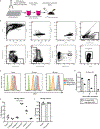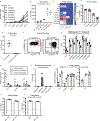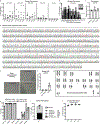Long-term ex vivo haematopoietic-stem-cell expansion allows nonconditioned transplantation
- PMID: 31142833
- PMCID: PMC7006049
- DOI: 10.1038/s41586-019-1244-x
Long-term ex vivo haematopoietic-stem-cell expansion allows nonconditioned transplantation
Erratum in
-
Author Correction: Long-term ex vivo haematopoietic-stem-cell expansion allows nonconditioned transplantation.Nature. 2019 Jul;571(7766):E12. doi: 10.1038/s41586-019-1395-9. Nature. 2019. PMID: 31289376
Abstract
Multipotent self-renewing haematopoietic stem cells (HSCs) regenerate the adult blood system after transplantation1, which is a curative therapy for numerous diseases including immunodeficiencies and leukaemias2. Although substantial effort has been applied to identifying HSC maintenance factors through the characterization of the in vivo bone-marrow HSC microenvironment or niche3-5, stable ex vivo HSC expansion has previously been unattainable6,7. Here we describe the development of a defined, albumin-free culture system that supports the long-term ex vivo expansion of functional mouse HSCs. We used a systematic optimization approach, and found that high levels of thrombopoietin synergize with low levels of stem-cell factor and fibronectin to sustain HSC self-renewal. Serum albumin has long been recognized as a major source of biological contaminants in HSC cultures8; we identify polyvinyl alcohol as a functionally superior replacement for serum albumin that is compatible with good manufacturing practice. These conditions afford between 236- and 899-fold expansions of functional HSCs over 1 month, although analysis of clonally derived cultures suggests that there is considerable heterogeneity in the self-renewal capacity of HSCs ex vivo. Using this system, HSC cultures that are derived from only 50 cells robustly engraft in recipient mice without the normal requirement for toxic pre-conditioning (for example, radiation), which may be relevant for HSC transplantation in humans. These findings therefore have important implications for both basic HSC research and clinical haematology.
Conflict of interest statement
Figures









Comment in
-
How children's glue fixes a decades old enigma.Ann Transl Med. 2019 Dec;7(Suppl 8):S348. doi: 10.21037/atm.2019.09.90. Ann Transl Med. 2019. PMID: 32016066 Free PMC article. No abstract available.
References
-
- Osawa M, Hanada K, Hamada H, Nakauchi H. Long-term lymphohematopoietic reconstitution by a single CD34-low/negative hematopoietic stem cell. Science 1996;273(5272):242–245. - PubMed
-
- Copelan EA. Hematopoietic stem-cell transplantation. N Engl J Med 2006;354(17):1813–1826. - PubMed
-
- Yamazaki S, Ema H, Karlsson G, et al. Nonmyelinating Schwann cells maintain hematopoietic stem cell hibernation in the bone marrow niche. Cell 2011;147(5):1146–1158. - PubMed
MeSH terms
Substances
Grants and funding
LinkOut - more resources
Full Text Sources
Other Literature Sources
Medical

